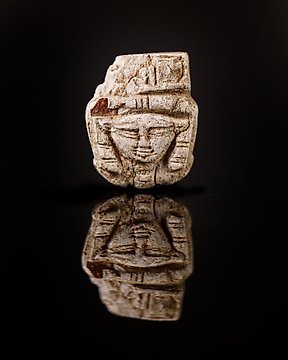
Egiptul Antic Faianță amuleta zeitei Hathor - 2.2 cm
Nr. 84074837

Nr. 84074837

Inlay of an amulet of the genie Kebehsenuf
CULTURE: Ancient Egypt
PERIOD: Late Period, 664 - 323 BC.
MATERIAL: Stone
DIMENSIONS: 3,7 cm height.
PROVENANCE:
- Private collection, B., Lyon, France. 1960.
CONSERVATION: Intact.
DESCRIPTION:
Amulet with the body in human form, crouched, covered by a shroud, with a falcon's head and tripartite wig. The back is completely flat, retaining traces of black engobe. This fact allows us to identify the object as an inlay, a piece made to be embedded in a larger element as part of the decoration. The most plausible option of its use is a wooden sarcophagus, there are examples, such as the sarcophagus of the priest Petosiris, in which five columns of hieroglyphic writing were carved on its body, each symbol being an inlay, made in this case in faience of different colors. In other cases only a necklace with a deity, like the one studied here, inside a pectoral, composed of different types of stone, each one contributing its characteristic color. The options are varied, but it is clear that this is a decorative technique used by the ancient Egyptians to provide a natural color to the sarcophagi, denoting both quality and status, as some of the stones, even gems, were expensive to acquire and therefore were available to the wealthiest or those who had positions of great importance within the administration or priesthood.
He represents the deity or genie Kebehsenuf or Qebehsenuf, one of the four sons of Horus and Hathor and brother of Amset, Duamutef and Hapi in Egyptian mythology. His name means "he who refreshes his brothers" and is a divinity associated with the protection of the West. In the preparation of the mummies, one of the four canopic vessels, the one used for the intestines, represented him in the form of a mummy with a falcon's head. He was protected in turn by the goddess Serket. As funerary divinity, together with his brothers and the divinities Maa-ateff, Jeri-beqf and Horus-Jentimaa formed "the seven shining ones", they were the protectors of the body of Osiris.
Notes:
The seller guarantees that he acquired this piece according to all national and international laws related to the ownership of cultural property. Provenance statement seen by Catawiki.
The seller will take care that any necessary permits, like an export license will be arranged, he will inform the buyer about the status of it if this takes more than a few days.
The piece includes authenticity certificate.
The piece includes Spanish Export License.
THE MINISTRY OF CULTURE FROM SPAIN ASKS ALL SELLERS FOR INVOICES OR OTHER DOCUMENTATION ABLE TO PROVE THE LEGALITY OF EACH ITEM BEFORE PROVIDING AN IMPORT OR EXPORT LICENSE.
#alienscollection
Cum să cumperi de la Catawiki
1. Descoperă ceva special
2. Plasează cea mai mare ofertă
3. Fă o plată sigură